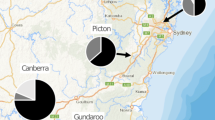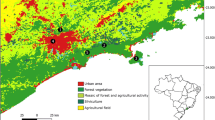Abstract
A termite colony is usually founded by a pair of alates, the primary reproductives, which produce all the nestmates. In some species, secondary reproductives appear to either replace the primaries or supplement colony reproduction. In termites, secondary reproductives are generally ergatoids derived from workers or nymphoids derived from nymphs. Silvestritermes euamignathus is a termite species that forms multiple nymphoid reproductives, and to date it was hypothesized that these secondary reproductives were the progeny of the primary founding reproductives. We developed markers for 12 microsatellite loci and used COI mitochondrial DNA (mtDNA) to genotype 59 nymphoid neotenics found in a colony of S. euamignathus to test this hypothesis. Our results showed that nymphoids of S. euamignathus are not all siblings. The microsatellite analysis suggests that the secondary reproductives derived from a minimum of four different pairs of reproductives belonging to at least two different matrilines. This is the first record of non-sibling secondary reproductives occupying the same nest in a higher termite. These unrelated reproductives might be the result of either pleometrotic colony foundation or colony fusion.


Similar content being viewed by others
References
Araujo RL (1958) Contribuição à biogeografia dos térmitas de São Paulo, Brasil (Insecta, Isoptera). Arq Inst Biol 25:185–217
Atkinson L, Adams ES (1997) The origins and relatedness of multiple reproductives in colonies of the termite Nasutitermes corniger. Proc R Soc Lond B 264:1131–1136
Barbosa JRC, Moura FMS, Bandeira AG, Vasconcellos A (2012) Caste differentiation pathways in the neotropical termite Armitermes holmgreni (Isoptera: Termitidae). Zool Sci 29:738–742
Coles-de-Negret HR, Redford K (1982) The biology of nine termite species (Isoptera: Termitidae) from the cerrado of Central Brazil. Psyche 89(1-2):81–106
Costa-Leonardo AM, Barsotti RC, Soares HX (1996) Multiple nymphoid reproductives in the nests of the neotropical termite, Armitermes euamignathus (Isoptera, Termitidae, Nasutitermitinae). Sociobiology 28(2):197–205
Costa-Leonardo AM, Soares HX, Barsotti RC (1998) Response to orphaning in two neotropical termites: Armitermes euamignathus and Embiratermes festivellus. Entomol Exp Appl 88:109–114
Costa-Leonardo AM, Barsotti RC, Soares HX (1999) Morphology of the nymphoid replacement reproductives in the neotropical termite Armitermes euamignathus (Isoptera, Termitidae, Nasutitermitinae). J Morphol 239(2):131–141
DeHeer CJ, Vargo EL (2004) Colony genetic organization and colony fusion in the termite Reticulitermes flavipes as revealed by foraging patterns over time and space. Mol Ecol 13:431–441
DeHeer CJ, Vargo EL (2008) Strong mitochondrial DNA similarity but low relatedness at microsatellite loci among families within fused colonies of the termite Reticulitermes flavipes. Insect Soc 55:190–199
Fougeyrollas R, Dolejšová K, Sillam-Dussès D, Roy V, Poteaux C, Hanus R, Roisin Y (2015) Asexual queen succession in the higher termite Embiratermes neotenicus. Proc R Soc Lond B 282:20150260
Goudet J (2002) FSTAT, a program to estimate and test gene diversities and fixation indices
Guaraldo AC, Costa-Leonardo AM (2009) Preliminary fusion testing between whole young colonies of Coptotermes gestroi (Isoptera: Rhinotermitidae). Sociobiology 53:767–774
Hacker M, Kaib M, Bagine RKN, Epplen JT, Brandl R (2005) Unrelated queens coexist in colonies of the termite Macrotermes michaelseni. Mol Ecol 14:1527–1532
Hartke TR, Baer B (2011) The mating biology of termites: a comparative review. Anim Behav 82(5):927–936
Hartke TR, Rosengaus RB (2013) Costs of pleometrosis in a polygamous termite. Proc R Soc Lond B Biol Sci 280:20122563
Koressaar T, Remm M (2007) Enhancements and modifications of primer design program Primer3. Bioinformatics 23(10):1289–91
Luchetti A, Dedeine F, Velonà A, Mantovani B (2013) Extreme genetic mixing within colonies of the wood-dwelling termite Kalotermes flavicollis (Isoptera, Kalotermitidae). Mol Ecol 22:3391–3402
Mathews AG (1977) Studies on termites from the Mato Grosso state, Brazil. Academia Brasileira de Ciências, Rio de Janeiro, p 267
Matsuura K, Nishida T (2001) Colony fusion in a termite: what makes the society “open”? Insect Soc 48:378–383
Matsuura K, Vargo EL, Kawatsu K, Labadie PE, Nakano H, Yashiro T, Tsuji K (2009) Queen succession through asexual reproduction in termites. Science 323:1687
Miller LR (1969) Caste differentiation in the lower termites. In: Biology of Termites. Krishna K, Weesner FM (eds) pp. 283-310
Myles TG (1999) Review of secondary reproduction in termites (Insecta: Isoptera) with comments on its role in termite ecology and social evolution. Sociobiology 33:1–91
Noirot C (1956) Les sexués de remplacement chez les termites supérieurs (Termitidae). Insect Soc 3:145–148
Noirot C (1969) Formation of castes in higher termites. In: Biology of Termites. Krishna K, Weesner FM (eds) pp. 311-350
Rocha MM, Cancello EM, Carrijo TF (2012) Neotropical termites: revision of Armitermes Wasmann (Isoptera, Termitidae, Syntermitinae) and phylogeny of the Syntermitinae. Syst Entomol 37:793–827
Roisin Y, Pasteels JM (1985) Imaginal polymorphism and polygyny in the Neo-Guinean termite Nasutitermes princeps (Desneux). Insect Soc 32:140–157
Roisin Y, Pasteels JM (1986a) Replacement of reproductives in Nasutitermes princeps (Desneux) (Isoptera: Termitidae). Behav Ecol Sociobiol 18:437–442
Roisin Y, Pasteels JM (1986b) Differentiation of worker-derived intercastes and precocious imagoes after queen removal in the Neo-Guinean termite Nasutitermes princeps (Desneux). J Morphol 189:281–293
Thorne BL (1982) Polygyny in termites: multiple primary queens in colonies of Nasutitermes corniger (Motschulsky) (Isoptera: Termitidae). Insect Soc 29:102–117
Thorne BL (1984) Polygyny in the neotropical termite Nasutitermes corniger: life history consequences of queen mutualism. Behav Ecol Sociobiol 14:117–136
Thorne BL, Breisch NL, Muscedere ML (2003) Evolution of eusociality and the soldier caste in termites: influence of intraspecific competition and accelerated inheritance. Proc Natl Acad Sci 100(22):12808–12813
Untergrasser A, Cutcutache I, Koressaar T, Ye J, Faircloth BC, Remm M, Rozen SG (2012) Primer3—new capabilities and interfaces. Nucleic Acids Res 40(15):e115
Vargo EL, Husseneder C (2011) Genetic structure of termite colonies and populations. In: Biology of Termites: a modern synthesis. Bignell DE, Roisin Y, Lo N (eds) pp. 321-347
Vargo EL, Labadie PE (2012) Matsuura K (2012) Asexual queen succession in the subterranean termite Reticulitermes virginicus. Proc R Soc B Biol Sci 279(1729):813–819
Wu J, Su X, Kong X, Liu M, Xing L (2013) Multiple male and female reproductive strategies and the presence of a polyandric mating system in the termite Reticulitermes labralis (Isoptera: Rhinotermitidae). Sociobiology 60(4):459–465
Ye C, Ma ZS, Cannon CH, Pop M, Yu DW (2012) Exploiting sparseness in de novo genome assembly. BMC Bioinformatics 13(Suppl 6):S1
Acknowledgments
The authors thank FAPESP (Process No. 2012/23898-0, 2014/00720-6 and 2014/25857-4) and CNPq (Process No. 305539/2014-0) for financial support. The authors also thank the four anonymous reviewers for their critical contributions.
Author information
Authors and Affiliations
Corresponding author
Additional information
Communicated by: Sven Thatje
Rights and permissions
About this article
Cite this article
Haifig, I., Vargo, E.L., Labadie, P. et al. Unrelated secondary reproductives in the neotropical termite Silvestritermes euamignathus (Isoptera: Termitidae). Sci Nat 103, 9 (2016). https://doi.org/10.1007/s00114-015-1325-0
Received:
Revised:
Accepted:
Published:
DOI: https://doi.org/10.1007/s00114-015-1325-0




